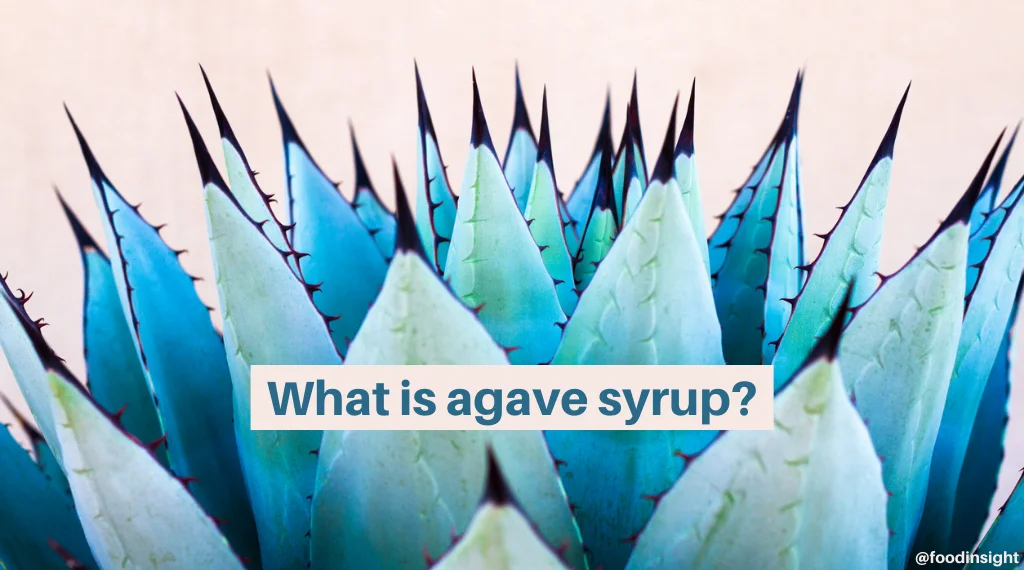Highlights
- Agave syrup comes from the agave plant, a succulent that is native to dry regions in Mexico.
- Agave syrup predominantly consists of fructose and some glucose, along with water, as well as small amounts of other carbohydrates, fat, polyols and vitamins and minerals.
- The sugars in agave syrup comprise around 80% fructose and 20% glucose.
- Due to its high fructose concentration, agave syrup is sweeter than table sugar and has less of an impact on blood glucose levels.
- The U.S. Food and Drug Administration has established specific labeling requirements for the Nutrition Facts of single-ingredient sugars such as pure agave syrup, honey and maple syrup.
- Agave syrup is not healthier than other sugars, but there are a few differences that make it an appealing choice for some.
Sugars come in many different forms, including syrups like corn syrup and maple syrup, which are viscous liquid sweeteners. One type of syrup that recently has become more familiar to consumers is agave syrup. Scientifically speaking, agave syrup is a type of carbohydrate, mainly consisting of the simple sugars (monosaccharides) fructose and glucose.
Where does agave syrup come from?
Agave syrup comes from the agave plant, a succulent that is native to dry regions in Mexico. It primarily comes from two varieties of agave: blue and salmiana. Blue agave also is famous for its use in tequila-making (see its scientific name, Agave tequilana).
The agave plant contains inulin, a non-sweet, non-digestible water-soluble polysaccharide, as well as other carbohydrates and sugars. Agave syrup results from the harvesting and processing of the agave plant’s core (which resembles a pineapple and is known as the “piña”) through a sequence of heating, juicing, filtering and evaporation that eventually yields the liquid sweetener.
Is agave syrup a natural or added sugar?
Like pure maple syrup and pure honey, agave syrup is considered an added sugar when consumed on its own, when added to foods or beverages, or when included as an ingredient in foods or beverages. Although pure agave syrup contains naturally occurring sugars and has no sugars added during its production, consuming agave syrup contributes extra calories to one’s diet without providing nutrients—thus earning the label of “added sugar.”
The requirements for the ways that sugars are labelled on the Nutrition Facts labels of food products in the U.S. attempt to address this nuance. According to the U.S. Food and Drug Administration, single-ingredient sugars, such as pure agave syrup, honey and maple syrup, are not required to declare their sugar content as “Added Sugars.” Instead, their sugars can be listed as “Total Sugars.” However, a “†” symbol must appear alongside the percent Daily Value (DV) on the Nutrition Facts label. This symbol directs consumers to a footnote in the Nutrition Facts label box that includes a description of the gram amount of sugar added to the diet by one serving of the product as well as its contribution to the percent DV for added sugars. Here’s an example of the “†” symbol statement: “One serving adds 17g of sugar to your diet and represents 34% of the Daily Value for Added Sugars.”
Although the amount of added sugars that Americans consume has decreased during the last two decades, about six in ten U.S. adults still eat more added sugars than is recommended.
How is agave syrup digested?
One tablespoon of agave syrup has about 60 calories and 15 grams of sugars. Agave syrup consists of monosaccharides (predominantly fructose and some glucose), water, and small amounts of other carbohydrates, fat, polyols, vitamins and minerals. The Mexican government has set standards for agave syrup that stipulate specific minimum and maximum concentrations of fructose and glucose. Typically, around 80% of the sugars in agave syrup are fructose and 20% are glucose. By comparison, the sugars breakdown of simple syrup (i.e. sucrose (table sugar) dissolved in water) is equal parts of two monosaccharides: 50% fructose and 50% glucose.
When we consume agave syrup, the way our bodies break it down for energy is similar to the way other sugars are digested. Glucose ultimately gets taken up by our cells with the help of insulin, while fructose is processed by the liver and does not need insulin to be absorbed. Due to its higher fructose content, agave syrup has less of an impact on blood glucose levels than most other sugars.
Some people have trouble absorbing fructose when eating it in large amounts and some are unable to absorb fructose at all. For affected individuals, it is recommended to monitor or limit fructose intake, and in the case of the rare genetic disorder called hereditary fructose intolerance (HFI), to avoid it entirely. About one in 20,000–30,000 people are born with HFI each year. Because individuals with HFI cannot metabolize fructose, foods and beverages containing fructose, sucrose or the sugar alcohol sorbitol must be excluded from their diet.
Does agave syrup have health benefits?
Although agave syrup is not healthier than other sugars, there are a few differences that make it an appealing choice for some. For example, agave syrup is thinner in consistency than honey and thus more soluble in liquids—so it mixes better into cold beverages. Agave syrup is also sweeter than other sugars that have a more equal mixture of fructose and glucose. Because it is sweeter, fewer calories of agave syrup are needed to match the sweetness of sugars like sucrose.
Consumption of agave syrup raises blood sugar less than most other sugars due to its higher fructose content. Yet, there has been debate over the decades about the impact of fructose on health because fructose is metabolized differently than glucose. Some researchers have suggested that fructose may be uniquely detrimental to health. More recently, a 2018 systematic review and meta-analysis of controlled human studies found that negative health impacts of fructose-containing sugars were not due to fructose, but instead a result of sugars’ contribution to consuming excess calories.
U.S. Dietary Guidelines do not make recommendations for the types of added sugars to consume. Instead, they recommend limiting all added sugars, including agave syrup, to fewer than 10 percent of total calories consumed daily.


